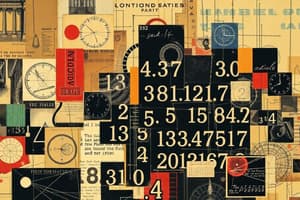Podcast
Questions and Answers
Which number system includes negative numbers?
Which number system includes negative numbers?
- Integers (Z) (correct)
- Whole Numbers (W)
- Rational Numbers (Q)
- Natural Numbers (N)
What is the outcome of applying the Commutative Property in addition?
What is the outcome of applying the Commutative Property in addition?
- The sum is doubled.
- Only one number can be added.
- The sum of the first two remains constant.
- Changing the order of numbers does not affect the sum. (correct)
When simplifying the fraction 8/12, what is the GCD of the numerator and denominator?
When simplifying the fraction 8/12, what is the GCD of the numerator and denominator?
- 3
- 2 (correct)
- 4
- 6
To convert a fraction to a decimal, which operation is performed?
To convert a fraction to a decimal, which operation is performed?
What is the formula for finding the area of a rectangle?
What is the formula for finding the area of a rectangle?
Which of the following statements is false regarding irrational numbers?
Which of the following statements is false regarding irrational numbers?
If you have 25% of a value, how do you find the original whole number?
If you have 25% of a value, how do you find the original whole number?
What is the result of dividing a fraction by another fraction?
What is the result of dividing a fraction by another fraction?
Flashcards are hidden until you start studying
Study Notes
Key Concepts in Mathematics 1
Number Systems
- Natural Numbers (N): Positive integers (1, 2, 3, ...).
- Whole Numbers (W): Natural numbers plus zero (0, 1, 2, ...).
- Integers (Z): Whole numbers and their negatives (..., -2, -1, 0, 1, 2, ...).
- Rational Numbers (Q): Numbers that can be expressed as a fraction (a/b, where b ≠ 0).
- Irrational Numbers: Numbers that cannot be expressed as fractions (e.g., √2, π).
- Real Numbers (R): All rational and irrational numbers.
Basic Arithmetic Operations
- Addition (+): Combining two numbers.
- Subtraction (−): Finding the difference between two numbers.
- Multiplication (×): Repeated addition of a number.
- Division (÷): Splitting a number into equal parts.
Properties of Operations
- Commutative Property:
- Addition: a + b = b + a
- Multiplication: a × b = b × a
- Associative Property:
- Addition: (a + b) + c = a + (b + c)
- Multiplication: (a × b) × c = a × (b × c)
- Distributive Property: a × (b + c) = (a × b) + (a × c)
Fractions
- Definition: A ratio of two integers (numerator/denominator).
- Simplifying: Dividing both numerator and denominator by their greatest common divisor (GCD).
- Addition/Subtraction: Find common denominator, adjust numerators, then operate.
- Multiplication: Multiply numerators together and denominators together.
- Division: Multiply by the reciprocal of the divisor.
Decimals
- Definition: A fractional number expressed in the base 10 system.
- Conversion:
- Fraction to Decimal: Divide numerator by denominator.
- Decimal to Fraction: Use place value to write as a fraction (e.g., 0.75 = 75/100 = 3/4).
Percentages
- Definition: A fraction expressed as a part of 100.
- Calculation:
- To find percentage: (part/whole) × 100.
- To find part: (percentage × whole) / 100.
Algebra
- Variables: Symbols representing numbers (e.g., x, y).
- Expressions: Combinations of variables and constants (e.g., 3x + 2).
- Equations: Statements that two expressions are equal (e.g., 2x + 3 = 7).
- Solving Equations: Isolate the variable using inverse operations.
Geometry
- Basic Shapes:
- Triangle: 3 sides
- Square: 4 equal sides
- Rectangle: 4 sides, opposite sides equal
- Circle: Round shape with a constant radius.
- Perimeter: Sum of all sides of a shape.
- Area: Surface covered by a shape.
- Triangle: 1/2 × base × height.
- Rectangle: length × width.
- Circle: π × radius².
Data Handling
- Mean: Average of a set of numbers.
- Median: Middle value when data is organized in order.
- Mode: Most frequently occurring value.
- Range: Difference between the highest and lowest values in a data set.
Basic Probability
- Definition: Measure of the likelihood of an event occurring.
- Formula: Probability (P) = Number of favorable outcomes / Total number of outcomes.
Number Systems
- Natural Numbers (N): These are the counting numbers, starting from 1 and going up indefinitely (1, 2, 3, ...).
- Whole Numbers (W): These are the natural numbers plus zero (0, 1, 2, ...), encompassing all positive integers and the number zero.
- Integers (Z): Integers include all whole numbers but also their negative counterparts (..., -2, -1, 0, 1, 2, ...).
- Rational Numbers (Q): Rational numbers are those that can be expressed as a fraction, where the numerator and denominator are integers, and the denominator is not zero (a/b, where b ≠ 0).
- Irrational Numbers: Numbers that cannot be expressed as a simple fraction are called irrational. Examples include the square root of 2 (√2) and pi (π).
- Real Numbers (R): The set of real numbers encompasses all rational and irrational numbers. This means almost any number you can think of is a real number.
Basic Arithmetic Operations
- Addition (+): Represents combining two numbers together.
- Subtraction (−): Represents finding the difference between two numbers.
- Multiplication (×): Repeated addition of the same number.
- Division (÷): Splitting a larger number into equal, smaller parts.
Properties of Operations
- Commutative Property: The order of operations doesn't matter for addition and multiplication.
- Addition: a + b = b + a (e.g., 2 + 3 = 3 + 2)
- Multiplication: a × b = b × a (e.g., 2 × 3 = 3 × 2)
- Associative Property: Grouping doesn't affect the outcome of addition and multiplication.
- Addition: (a + b) + c = a + (b + c) (e.g., (2 + 3) + 4 = 2 + (3 + 4))
- Multiplication: (a × b) × c = a × (b × c) (e.g., (2 × 3) × 4 = 2 × (3 × 4))
- Distributive Property: This allows you to multiply a number by a sum by multiplying each term in the sum separately and then adding the results.
- a × (b + c) = (a × b) + (a × c) (e.g., 2 × (3 + 4) = (2 × 3) + (2 × 4))
Fractions
- Definition: A fraction represents a part of a whole and is written as a ratio of two integers (numerator/denominator).
- Simplifying: To simplify a fraction, divide both the numerator and denominator by their greatest common divisor (GCD).
- Addition/Subtraction: When adding or subtracting fractions, you need to find a common denominator for both fractions, adjust the numerators, and then perform the operation on the numerators.
- Multiplication: To multiply fractions, multiply the numerators together and the denominators together.
- Division: To divide fractions, multiply the first fraction by the reciprocal of the second fraction.
Decimals
- Definition: Decimals are fractional numbers expressed using the base 10 system, where a dot (.) separates the whole number part from the fractional part.
- Conversion:
- Fraction to Decimal: Divide the numerator of the fraction by the denominator.
- Decimal to Fraction: Use place value to determine the fraction. For example, 0.75 is equivalent to 75/100, which can be simplified to 3/4.
Percentages
- Definition: A percentage represents a fraction expressed as a part of 100.
- Calculation:
- To find the percentage: Divide the part by the whole and multiply by 100.
- To find the part: Multiply the percentage by the whole and divide by 100.
Algebra
- Variables: Variables are symbols used to represent unknown numbers in equations.
- Expressions: Algebraic expressions combine variables and constants using arithmetic operations (e.g., 3x + 2).
- Equations: Equations express the equality between two algebraic expressions (e.g., 2x + 3 = 7).
- Solving Equations: To solve an equation for a variable, you use inverse operations to isolate the variable on one side of the equation.
Geometry
- Basic Shapes:
- Triangle: A polygon with three sides and three angles.
- Square: A quadrilateral with four equal sides and four right angles.
- Rectangle: A quadrilateral with four sides, where opposite sides are equal and all angles are right angles.
- Circle: A closed curve where all points are equidistant from a central point (the center).
- Perimeter: The total length of all the sides of a shape.
- Area: The amount of surface covered by a shape.
- Triangle: Area = 1/2 × base × height
- Rectangle: Area = length × width
- Circle: Area = π × radius²
Data Handling
- Mean: The average of a set of numbers, calculated by summing all the numbers and dividing by the total number of values.
- Median: The middle value in a data set when it is arranged in order.
- Mode: The value that occurs most frequently in a data set.
- Range: The difference between the highest and lowest values in a data set.
Basic Probability
- Definition: Probability measures the likelihood of a particular event occurring.
- Formula: Probability (P) = Number of favorable outcomes / Total number of outcomes.
Studying That Suits You
Use AI to generate personalized quizzes and flashcards to suit your learning preferences.




